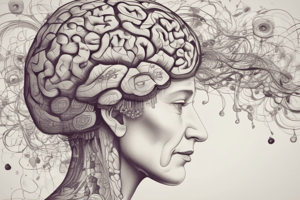Podcast
Questions and Answers
Where are higher rates of Alzheimer's disease observed?
Where are higher rates of Alzheimer's disease observed?
- North America and Europe (correct)
- North America and Asia
- South America and Africa
- Australia and Europe
What is the primary purpose of a CT scan in diagnosing Alzheimer's disease?
What is the primary purpose of a CT scan in diagnosing Alzheimer's disease?
- To produce detailed images of the brain
- To monitor the progression of the disease
- To rule out tumors, strokes, and head injuries (correct)
- To diagnose Alzheimer's disease definitively
What type of imaging scan shows areas of the brain where nutrients are poorly metabolized?
What type of imaging scan shows areas of the brain where nutrients are poorly metabolized?
- X-ray
- FDG PET (correct)
- MRI
- CT
What is the primary mechanism of action of cholinesterase inhibitors?
What is the primary mechanism of action of cholinesterase inhibitors?
What is a common oral health issue in Alzheimer's disease patients due to medication side effects?
What is a common oral health issue in Alzheimer's disease patients due to medication side effects?
What is a challenge in dental management of Alzheimer's disease patients?
What is a challenge in dental management of Alzheimer's disease patients?
What is a common consequence of poor oral hygiene in Alzheimer's disease patients?
What is a common consequence of poor oral hygiene in Alzheimer's disease patients?
What type of therapy is used to manage symptoms and improve quality of life in Alzheimer's disease patients?
What type of therapy is used to manage symptoms and improve quality of life in Alzheimer's disease patients?
What is the definitive method of diagnosing Alzheimer's disease?
What is the definitive method of diagnosing Alzheimer's disease?
What is a common dental issue in Alzheimer's disease patients due to reduced adhesion of the prosthesis?
What is a common dental issue in Alzheimer's disease patients due to reduced adhesion of the prosthesis?
Flashcards are hidden until you start studying
Study Notes
Alzheimer's Disease: Overview
- Alzheimer's disease is a brain disorder that worsens over time, characterized by changes in the brain that lead to protein deposition, brain shrinkage, and eventually death.
- It is the most common cause of dementia, resulting in a gradual deterioration in memory, thinking ability, behavioral and social skills.
Genetic Basis
- Alzheimer's disease exhibits genetic heterogeneity, with two main types: Early-Onset Alzheimer's Disease (EOAD) and Late-Onset Alzheimer's Disease (LOAD).
- EOAD is caused by mutations in three key genes: APP, PSEN1, and PSEN2, which affect the gamma-secretase complex and lead to increased amyloid-beta production.
- LOAD is influenced by multiple genes, including APOE, TREM2, SORL1, and CLU, and their interactions with environmental factors.
Pathophysiology
- Abnormal processing of APP leads to the formation of extracellular amyloid plaques, which disrupt cell-to-cell communication and activate immune responses.
- Hyperphosphorylation of tau protein leads to the formation of intracellular neurofibrillary tangles, which disrupt microtubule function and impair nutrient and organelle transport.
- Amyloid plaques and tau tangles disrupt synaptic function, leading to synaptic loss and neuronal damage.
- Chronic inflammation in the brain, including microglia and astrocytes, contributes to neuroinflammation and exacerbates neuronal damage.
Epidemiology
- Alzheimer's disease affects approximately 5-10% of individuals over the age of 65, with a higher prevalence in older populations.
- The primary risk factor is age, but genetics, gender, and geographic factors also play a role.
- Alzheimer's disease is the 5th leading cause of death in adults over 65 years old and the 6th leading cause of death overall.
Clinical Manifestations
- Alzheimer's disease can only be diagnosed definitively by autopsy, but clinical suspicion can be confirmed using biomarkers and neuroimaging such as MRI, CT, and FDG PET.
- Treatment options include pharmacological interventions, such as cholinesterase inhibitors, and non-pharmacological interventions, such as cognitive therapy, physical exercise, and lifestyle modifications.
Oral and Dental Manifestations
- Alzheimer's disease can lead to poor oral hygiene, dry mouth, mouth ulcers, and gingival hyperplasia due to cognitive decline, medication use, and behavioral changes.
- Dental management challenges include behavioral issues, difficulty in cooperating during dental treatments, and the need for specialized care and accommodations.
Studying That Suits You
Use AI to generate personalized quizzes and flashcards to suit your learning preferences.




